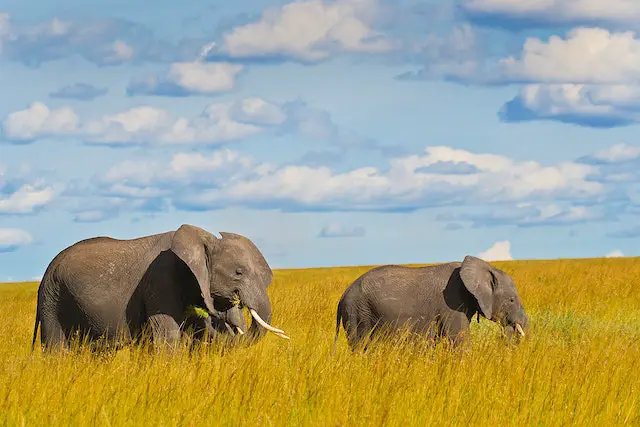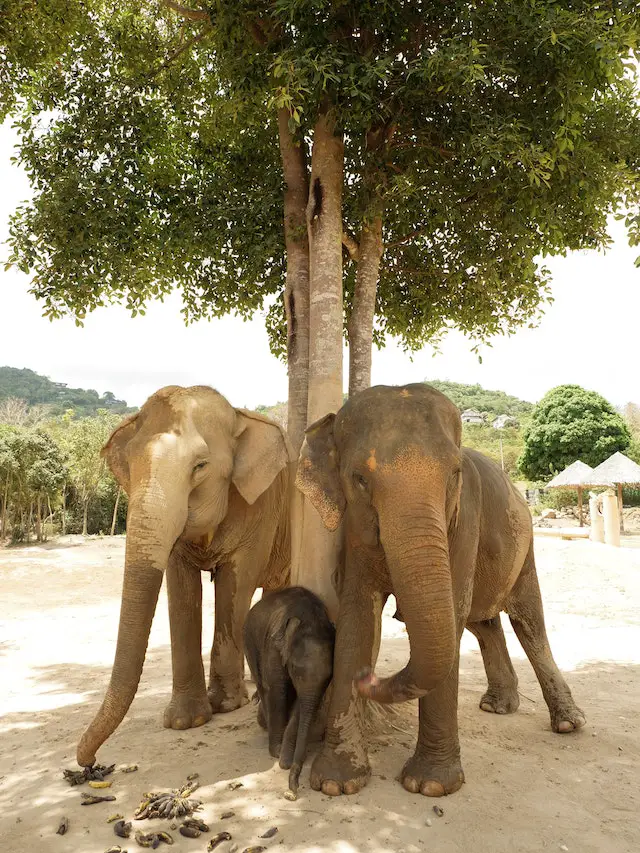African elephants are larger, have bigger ears, and roam in large herds across the savannas of Africa. Meanwhile, Asian elephants tend to be smaller with smaller ears, live in dense forests throughout Asia and primarily eat vegetation such as bamboo.
African elephants
(Photo by Brian Banford)

African elephants are the largest land animals on Earth and are found in 37 countries across the continent of Africa. They have distinctive large ears that help them to regulate their body temperature, as well as a long trunk that is used for grasping food and water. These magnificent creatures can weigh up to 6 tons and live for up to 70 years.
One notable feature of African elephants is their complex social structures. They live in herds led by a matriarch – usually the oldest female – who makes decisions about where they go and when they rest. The females within each herd have strong bonds with one another, often helping to raise each other’s young.
Another fascinating aspect of African elephants is their vocal communication system. Elephants use a variety of sounds including trumpets, rumbles, growls, and snorts to communicate with one another over long distances. In fact, some researchers believe that these sounds may be so low-pitched that humans cannot even hear them!
Sadly though, African elephants face many threats such as habitat loss due to human activity and poaching for ivory tusks which has caused significant declines in elephant populations throughout Africa in recent decades.
Asian elephants
(Photo by Katie Hollamby)

Asian elephants are a fascinating species of the elephant family and have several unique characteristics that distinguish them from their African counterparts. They can be found in various habitats across Asia, including forests, grasslands, and even deserts. Asian elephants are smaller than African elephants and have distinct ears that resemble the shape of India’s landmass.
These majestic creatures possess a wide range of skills and abilities that make them an essential part of many cultures across Asia. From carrying heavy loads to working with humans in agriculture, Asian elephants display remarkable intelligence, strength, and agility.
Sadly though, these magnificent animals face numerous threats such as habitat loss due to deforestation or human encroachment on their territories. Poaching for ivory trade is also another significant threat they face which has led to declining populations over time.
Asian elephants are a crucial component of biodiversity ecosystems across their native range in Asia. Ensuring their survival will require concerted efforts towards conservation measures aimed at protecting both habitats and individuals alike while minimizing conflicts between humans and these gentle giants.
African elephants Vs. Asian elephants – Key differences
African elephants and Asian elephants are both majestic creatures that draw awe from people all over the world. However, there are several key differences between these two species.
One of the most noticeable differences is their size. African elephants are typically larger than Asian elephants, with males weighing up to 6 tons while females can weigh up to 3 tons. In contrast, male Asian elephants only weigh around 5 tons and females weigh about half as much.
Another difference is the shape of their ears. African elephant’s ears have a rounded shape similar to the continent of Africa itself, whereas Asian elephant’s ears resemble a smaller version of India.
African elephants also have tusks that grow straight down from their upper jaw while those of an Asian elephant curve outwards towards its cheeks. Additionally, female African elephants also tend to have tusks compared to female Asian Elephants where it is rare for them to have visible tusks.
Their habitats also differ significantly with African Elephants being found throughout sub-Saharan Africa in savannas/grasslands whereas Asia Elephants thrive in tropical forests spread across southern Asia like India and Thailand
Both species may look quite similar at first glance but taking a closer look reveals many distinct differences between them – from physical characteristics down to habitat preferences!
Are Asian elephants as smart as African elephants?
One of the most common questions people ask about elephants is whether Asian elephants are as smart as African elephants. As it turns out, both species have demonstrated remarkable levels of intelligence in scientific studies.
For example, researchers have observed African elephants using objects like sticks and logs to scratch themselves and even create makeshift bridges over small bodies of water. Similarly, Asian elephants have been known to use tools like branches to swat at flies or dig for food.
In addition to their problem-solving skills, both African and Asian elephants demonstrate complex social behavior that suggests a high degree of emotional intelligence. Elephants can recognize individual members of their own group and mourn the loss of loved ones.
However, some researchers believe there may be subtle differences in cognitive abilities between the two species. For instance, one study found that African elephants were better at recognizing human voices than their Asian counterparts.
It seems clear that both types of elephant possess impressive intellects that rival those of many other animals on earth.
Can African elephants breed with Asian elephants?
Elephants are majestic creatures that have fascinated humans for centuries. With two distinct species, the African and Asian elephants, many people wonder if they can breed with one another.
The short answer is no; African and Asian elephants cannot interbreed. This is due to a difference in chromosome number between the two species, which makes it impossible for them to produce viable offspring.
In addition to this genetic barrier, there are also other differences between the two species that make breeding unlikely even if they could produce viable offspring. For example, African elephants tend to be larger than their Asian counterparts and have different physical characteristics such as longer tusks and ears.
While hybridization between these two elephant species may not be possible naturally, there have been attempts at artificial insemination in captivity with limited success. However, conservationists generally discourage such attempts due to concerns about preserving both genetic diversity within each species and preventing potential health risks for hybrid offspring.
While it may seem fascinating or even desirable for these two magnificent animals to mate and create new hybrids of elephant-kind, nature has ensured that each distinct species remains unique unto itself.
What are the 3 types of elephants?
There are three species of elephants – the African forest elephant, the African bush elephant and the Asian elephant. The African forest elephant is found in dense forests across central and West Africa while the African bush elephant is found in savannas and grasslands throughout sub-Saharan Africa.
The Asian elephant, on the other hand, inhabits tropical forests in countries like India, Thailand, Sri Lanka and Indonesia. Despite their shared name, there are many differences between these two types of elephants including physical characteristics such as size and shape of ears.
The Asian elephants have smaller ears compared to their African counterparts. Additionally, they have a more rounded forehead with a single dome while that of an African Elephant has two domes with a concave shape. Another difference lies in their trunk; Asian elephants possess one finger-like tip at the end while those of African Elephants have two fingers.
These differences may seem small but play a significant role in distinguishing them from each other. Understanding these variations is crucial for conservationists who work tirelessly to protect both species from extinction.
Are elephants aggressive?
Elephants are known for their gentle and peaceful nature. However, there are instances when elephants can become aggressive, especially in the wild or when they feel threatened.
One of the most common causes of aggression in elephants is human interference. Elephants may react aggressively to protect their young ones from perceived threats such as poachers or predators. They may also become aggressive if they feel cornered or trapped.
Elephant aggression can take many forms, including mock charges, trumpeting, and throwing objects with their trunks. In extreme cases, an elephant may attack humans or other animals using its tusks.
It’s worth noting that captive elephants are more likely to display aggressive behavior than those living in the wild due to factors like stress and confinement. That said, it’s essential always to approach elephants with caution and respect their personal space.
While elephants generally have a calm temperament towards humans and other animals alike; however should be treated with care since some circumstances might trigger defensive behavior on them!
Featured Images By – Photo by ROMAN ODINTSOV








